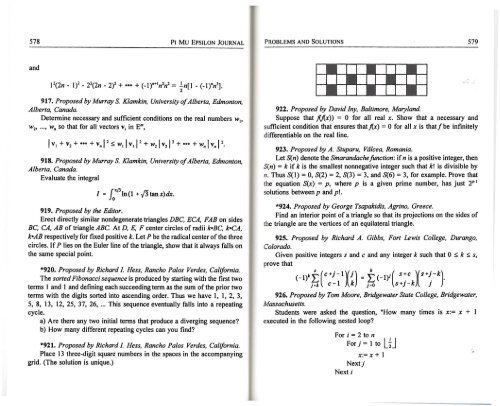Vol. 10 No 7 - Pi Mu Epsilon
Vol. 10 No 7 - Pi Mu Epsilon
Vol. 10 No 7 - Pi Mu Epsilon
Create successful ePaper yourself
Turn your PDF publications into a flip-book with our unique Google optimized e-Paper software.
578<br />
PI MU EPSILON JOURNAL<br />
PROBLEMS AND SOLUTIONS 579<br />
and<br />
1 2 (2n- Ii- 2 2 (2n- 2) 2 + ••• + (-l)n+ 1 n 2 n 2 = ..!.n[l - (-1rn 3 ].<br />
2<br />
917. Proposed by <strong>Mu</strong>rray S. Klamkin, University of Alberta, Edmonton,<br />
Alberta, Canada.<br />
Determine necessary and sufficient conditions on the real numbers w 1<br />
,<br />
w2, ... , wn so that for all vectors V; in Em,<br />
918. Proposed by <strong>Mu</strong>rray S. Klamkin, University of Alberta, Edmonton,<br />
Alberta, Canada.<br />
Evaluate the integral<br />
(n/3 <strong>Pi</strong><br />
I = lo ln(l + y3 tanx)dx.<br />
919. Proposed by the Editor.<br />
Erect directly similar nondegenerate triangles DBC, ECA, FAB on sides<br />
BC, CA, AB of triangle ABC. At D, E, F center circles of radii k•BC, k•CA,<br />
k•AB respectively for fixed positive k. Let P be the radical center of the three<br />
circles. If P lies on the Euler line of the triangle, show that it always falls on<br />
the same special point.<br />
*920. Proposed by Richard 1 Hess, Rancho Palos Verdes, California.<br />
The sorted Fibonacci sequence is produced by starting with the first two<br />
terms 1 and 1 and defining each succeeding term as the sum of the prior two<br />
terms with the digits sorted into ascending order. Thus we have 1, 1, 2, 3,<br />
5, 8, 13, 12, 25, 37, 26, ... This sequence eventually falls into a repeating<br />
cycle.<br />
a) Are there any two initial terms that produce a diverging sequence<br />
b) How many different repeating cycles can you find<br />
*921. Proposed by Richard l Hess, Rancho Palos Verdes, California.<br />
Place 13 three-digit square numbers in the spaces in the accompanying<br />
grid. (The solution is unique.)<br />
922. Proposed by David Iny, Baltimore, Maryland.<br />
Suppose that j{f{x)) = 0 for all real x. Show that a necessary and<br />
sufficient condition that ensures thatj{x) = 0 for all xis thatfbe infinitely<br />
differentiable on the real line. ·<br />
923. Proposed by A. Stuparu, Valcea, Romania.<br />
Let S(n) denote the Smarandachefunction: ifn is a positive integer, then<br />
S(n) = kif k is the smallest nonnegative integer such that k! is divisible by<br />
n. Thus S(l) = 0, S(2) = 2, S(3) = 3, and S(6) = 3, for example. Prove that<br />
the equation S(x) = p, where p is a given prime number, has just 2p- 1<br />
solutions between p and p!.<br />
*924. Proposed by George Tsapakidis, Agrino, Greece.<br />
Find an interior point of a triangle so that its projections on the sides of<br />
the triangle are the vertices of an equilateral triangle.<br />
925. Proposed by Richard A. Gibbs, Fort Lewis College, Durango,<br />
Colorado.<br />
Given positive integers s and c and any integer k such that 0 ::;; k ~ s,<br />
prove that<br />
(-l)Jct(c+j-l)(j) = E
















